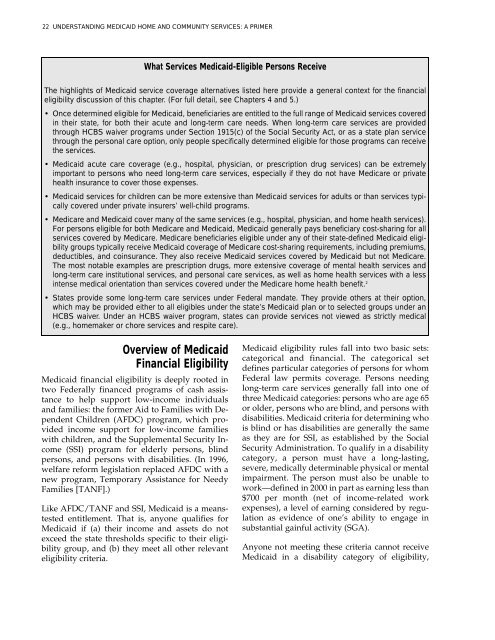Full PDF Version - ASPE - U.S. Department of Health and Human ...
Full PDF Version - ASPE - U.S. Department of Health and Human ...
Full PDF Version - ASPE - U.S. Department of Health and Human ...
- No tags were found...
Create successful ePaper yourself
Turn your PDF publications into a flip-book with our unique Google optimized e-Paper software.
22 UNDERSTANDING MEDICAID HOME AND COMMUNITY SERVICES: A PRIMERWhat Services Medicaid-Eligible Persons ReceiveThe highlights <strong>of</strong> Medicaid service coverage alternatives listed here provide a general context for the financialeligibility discussion <strong>of</strong> this chapter. (For full detail, see Chapters 4 <strong>and</strong> 5.)• Once determined eligible for Medicaid, beneficiaries are entitled to the full range <strong>of</strong> Medicaid services coveredin their state, for both their acute <strong>and</strong> long-term care needs. When long-term care services are providedthrough HCBS waiver programs under Section 1915(c) <strong>of</strong> the Social Security Act, or as a state plan servicethrough the personal care option, only people specifically determined eligible for those programs can receivethe services.• Medicaid acute care coverage (e.g., hospital, physician, or prescription drug services) can be extremelyimportant to persons who need long-term care services, especially if they do not have Medicare or privatehealth insurance to cover those expenses.• Medicaid services for children can be more extensive than Medicaid services for adults or than services typicallycovered under private insurers’ well-child programs.• Medicare <strong>and</strong> Medicaid cover many <strong>of</strong> the same services (e.g., hospital, physician, <strong>and</strong> home health services).For persons eligible for both Medicare <strong>and</strong> Medicaid, Medicaid generally pays beneficiary cost-sharing for allservices covered by Medicare. Medicare beneficiaries eligible under any <strong>of</strong> their state-defined Medicaid eligibilitygroups typically receive Medicaid coverage <strong>of</strong> Medicare cost-sharing requirements, including premiums,deductibles, <strong>and</strong> coinsurance. They also receive Medicaid services covered by Medicaid but not Medicare.The most notable examples are prescription drugs, more extensive coverage <strong>of</strong> mental health services <strong>and</strong>long-term care institutional services, <strong>and</strong> personal care services, as well as home health services with a lessintense medical orientation than services covered under the Medicare home health benefit. 2• States provide some long-term care services under Federal m<strong>and</strong>ate. They provide others at their option,which may be provided either to all eligibles under the state’s Medicaid plan or to selected groups under anHCBS waiver. Under an HCBS waiver program, states can provide services not viewed as strictly medical(e.g., homemaker or chore services <strong>and</strong> respite care).Overview <strong>of</strong> MedicaidFinancial EligibilityMedicaid financial eligibility is deeply rooted intwo Federally financed programs <strong>of</strong> cash assistanceto help support low-income individuals<strong>and</strong> families: the former Aid to Families with DependentChildren (AFDC) program, which providedincome support for low-income familieswith children, <strong>and</strong> the Supplemental Security Income(SSI) program for elderly persons, blindpersons, <strong>and</strong> persons with disabilities. (In 1996,welfare reform legislation replaced AFDC with anew program, Temporary Assistance for NeedyFamilies [TANF].)Like AFDC/TANF <strong>and</strong> SSI, Medicaid is a meanstestedentitlement. That is, anyone qualifies forMedicaid if (a) their income <strong>and</strong> assets do notexceed the state thresholds specific to their eligibilitygroup, <strong>and</strong> (b) they meet all other relevanteligibility criteria.Medicaid eligibility rules fall into two basic sets:categorical <strong>and</strong> financial. The categorical setdefines particular categories <strong>of</strong> persons for whomFederal law permits coverage. Persons needinglong-term care services generally fall into one <strong>of</strong>three Medicaid categories: persons who are age 65or older, persons who are blind, <strong>and</strong> persons withdisabilities. Medicaid criteria for determining whois blind or has disabilities are generally the sameas they are for SSI, as established by the SocialSecurity Administration. To qualify in a disabilitycategory, a person must have a long-lasting,severe, medically determinable physical or mentalimpairment. The person must also be unable towork—defined in 2000 in part as earning less than$700 per month (net <strong>of</strong> income-related workexpenses), a level <strong>of</strong> earning considered by regulationas evidence <strong>of</strong> one’s ability to engage insubstantial gainful activity (SGA).Anyone not meeting these criteria cannot receiveMedicaid in a disability category <strong>of</strong> eligibility,
















